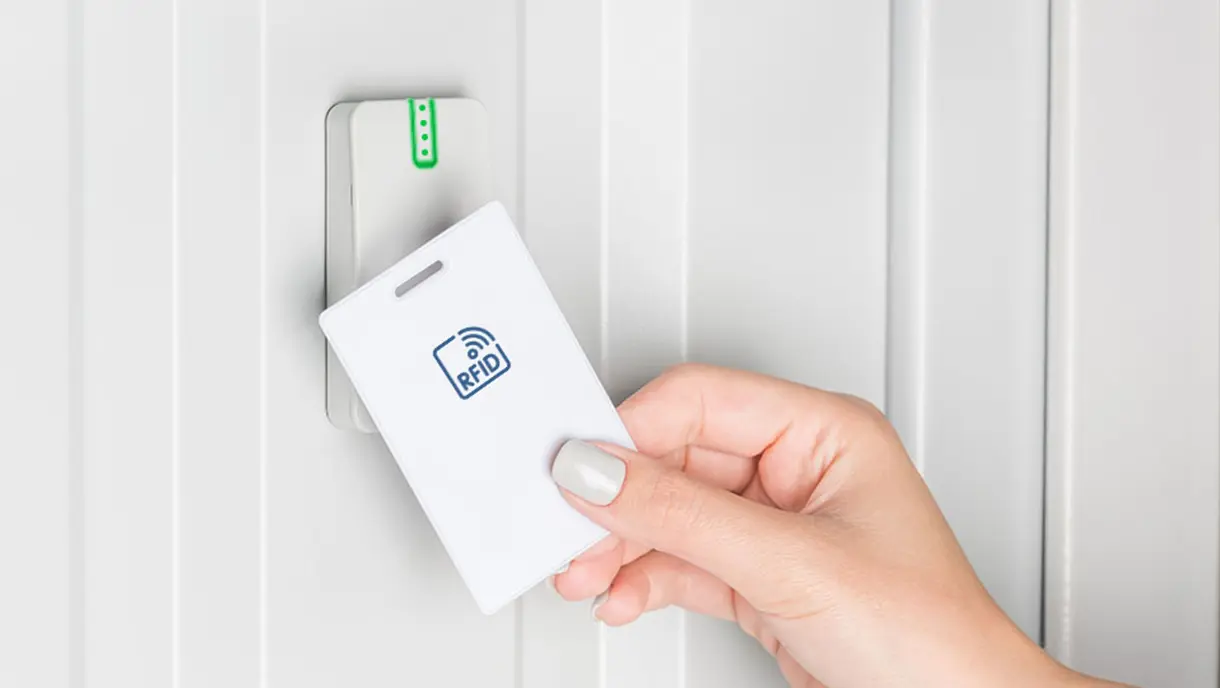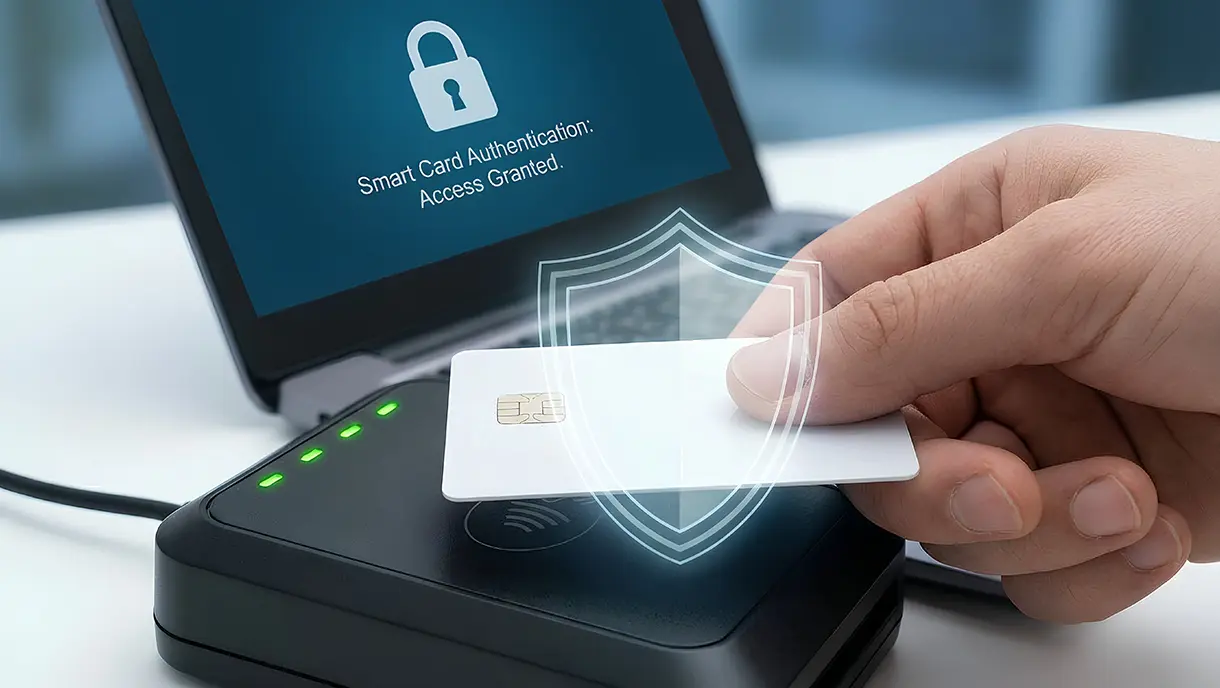What Is RFID Authentication and How Does It Work?
RFID authentication uses radio frequency technology to enable secure, contactless identity verification. It works through RFID tags and readers to grant quick and reliable access, making it a strong alternative to traditional methods like passwords or PINs. This blog explores how RFID authentication works, its applications, benefits, challenges, and best practices for effective implementation.

Passwords, PINs, and keys are no longer enough to keep workplaces and sensitive areas secure. Security needs to be fast, frictionless, and reliable, and that’s where RFID authentication comes in.
The RFID market is currently booming. According to a Global Market Insights report, the global RFID market reached $16.8 billion in 2024 and is expected to grow at a 12.7% annual rate through 2034, demonstrating the rapid adoption of this technology by businesses.
By using RFID for contactless identity verification, organizations can provide faster and safer access for employees, customers, and partners alike. From offices and hospitals to retail stores and warehouses, RFID authentication is helping industries stay secure while keeping things moving smoothly.
This blog explains how RFID-based authentication actually works. Explore its real-world applications, measurable benefits, and best practices for effective implementation. Let’s get started.
What Is RFID Authentication?
RFID authentication is a contactless security method that uses Radio Frequency Identification Technology (RFID) to verify a person or device. Users carry RFID cards, tags, or badges that store unique credentials.
When placed near an RFID reader, the credentials are transmitted wirelessly and compared to a database to determine whether access should be granted or denied. It’s fast, convenient, and widely used for secure entry, asset tracking, and payments.
RFID authentication comes in two main types:
- Active RFID: Equipped with a battery, these tags transmit signals over longer distances, ideal for tracking vehicles or high-value assets.
- Passive RFID: These tags rely on the reader’s energy and are commonly used in access cards, ID badges, and wearable devices.
Core Components of RFID Authentication
- RFID tags store unique identification codes on employee badges or cards. Passive tags receive power from the reader's electromagnetic field. Active tags contain batteries for a more extended range and continuous signal transmission.
- RFID readers act as the communication hub in your system. They transmit and receive radio waves to communicate with tags. Readers can be fixed on walls or portable for flexible deployment.
- Access control systems validate credentials and manage permissions. These systems connect readers to your security infrastructure and databases. They log every access attempt and trigger appropriate actions, such as unlocking doors.
Understanding these components helps you see how RFID creates a seamless authentication experience. The technology eliminates manual verification while maintaining robust security protocols. Now let's explore the exact authentication process that happens in under a second.
How Does RFID Authentication Work?
RFID authentication follows a precise sequence that instantly validates user credentials. The entire process is completed in under one second. Understanding each step helps you appreciate why this technology outperforms traditional authentication methods.
Step 1: Reader Initialization and Signal Emission
The RFID reader continuously emits low-power radio waves within its designated range. These electromagnetic signals create an activation field around the reader based on your system's frequency configuration. The reader remains in a listening state while broadcasting, waiting for any RFID tag to enter its field of view.
System Frequency Ranges
- Low-frequency systems operate at 125 kHz for close-range applications.
- High-frequency systems work at 13.56 MHz for moderate distances.
- Ultra-high frequency systems reach 860-960 MHz for longer ranges.
- Passive monitoring ensures no authentication attempts go undetected.
Step 2: Tag Detection and Activation
When an employee presents their badge, the tag enters the reader's electromagnetic field, and its internal antenna captures radio wave energy. This harvested energy powers the tag's microchip within milliseconds in passive systems, while active tags use internal batteries.
The microchip activates and retrieves stored credential data from its non-volatile memory.
Activation Process
- Passive tags harvest power from the reader's electromagnetic field.
- Active tags use batteries for extended range capabilities.
- The tag prepares to transmit its unique identifier and access permissions.
Step 3: Data Transmission and Encoding
The activated tag modulates the captured energy with its stored information and reflects modified signals to the reader using backscatter modulation. Modern RFID systems employ advanced encryption protocols during transmission to prevent unauthorized interception or credential cloning.
The reader's antenna captures these reflected signals, with multiple antennas working simultaneously to improve reliability.
Transmission Security Features
- Backscatter modulation enables tags to communicate without the need for transmitters.
- Encrypted data includes employee ID and access permissions codes.
- Multiple antennas can read tags simultaneously for better accuracy.
- Anti-collision algorithms distinguish between different tags when multiple are present.
Step 4: Signal Processing and Decoding
The reader converts received radio signals into digital data and decodes the encrypted information using predefined security protocols. The system extracts unique identifiers and associated credential information while running integrity checks to verify the accuracy of transmission. Any corrupted or incomplete data triggers an automatic re-read request.
Data Processing Steps
- Digital conversion happens through advanced signal processing.
- Anti-collision algorithms prevent errors in high-traffic areas.
- Integrity checks ensure only accurate credentials proceed.
- Corrupted data triggers immediate re-authentication attempts.
Step 5: Credential Verification
The reader forwards decoded credentials to your access control system, which queries its authorization database for matching records. The system verifies the employee has permission for the requested location and validates time-based restrictions against the current access attempt. Additional verification requirements, such as multi-factor authentication, may apply to sensitive areas.
Verification Checkpoints
- The database query confirms that the credentials match active employee accounts.
- Location-specific permissions are checked in real-time.
- Time-based access restrictions are validated automatically.
- Multi-factor authentication adds an extra layer of security when needed.
Step 6: Access Decision and Action
The access control system makes an immediate grant or deny decision based on all verification results. Approved credentials trigger connected door locks or system login mechanisms within one second of badge presentation.
Every authentication event generates a permanent log entry with detailed metadata, including timestamp, location, and decision outcome.
Decision Outcomes
- Authentication completes within one second of badge presentation.
- Approved access triggers door locks or system logins instantly.
- Failed attempts generate alerts for security monitoring.
- Detailed logging supports compliance and forensic investigations.
Step 7: Continuous Monitoring and Audit Trail
Modern RFID authentication systems maintain constant communication with your security infrastructure and receive real-time updates when access permissions change. Every authentication event creates permanent records that capture who accessed what resources and when.
The system can detect tampering attempts or unauthorized reader installations while scaling effortlessly as your organization grows.
Ongoing System Capabilities
- Terminated employees lose access immediately across all locations.
- Audit trails support regulatory compliance requirements.
- Anomalous patterns trigger automatic security alerts.
- Centralized management enables easy updates and scaling.
This seamless seven-step process happens entirely in the background without disrupting employee workflows. Your team simply taps their badge and gains instant access to authorized resources. Now, let's explore the types of FRID authentication.
Types of RFID Authentication Systems
RFID authentication systems vary in frequency, power source, and security capabilities. Choosing the right type can enhance efficiency, control, and protection for assets, people, and data. Below is a detailed look at the significant types of RFID authentication systems.
1. Low-Frequency (LF) RFID Systems
LF RFID operates between 125 and 134 kHz and is highly reliable in environments prone to interference, such as metal or water. These systems are ideal for applications requiring short read ranges and secure, straightforward identification processes.
- Key Characteristics: Offers short reading ranges up to 10 cm with slower data transfer rates but high resistance to interference, making it suitable for secure environments and simple identification tasks.
- Use Cases: Widely used for door access control, animal tagging, secure entry badges, and small-scale inventory tracking in industrial or agricultural settings.
- Security Level: Provides moderate security. Often combined with PIN codes or encryption to protect credentials and prevent unauthorized duplication or access attempts.
2. High-Frequency (HF) RFID Systems
HF RFID systems operating at 13.56 MHz offer faster communication and longer read ranges compared to LF systems. They are popular in public services, payments, and smart access cards due to their efficiency and support for advanced security protocols.
- Key Characteristics: Supports reading ranges of up to 1 meter, enabling faster data transfer and allowing for contactless applications in high-traffic areas while maintaining consistent performance.
- Use Cases: Ideal for contactless payments, smart cards, public transport passes, library cards, and secure staff access control systems.
- Security Level: High security with mutual authentication and cryptographic protections that prevent cloning or eavesdropping, making it suitable for sensitive transactions.
3. Ultra-High-Frequency (UHF) RFID Systems
UHF RFID systems operate in the 860-960 MHz range and are designed for applications requiring fast processing and long read distances. They excel in high-volume environments and large-scale monitoring operations.
- Key Characteristics: Delivers reading ranges over 10 meters with rapid data throughput, making it efficient for large warehouses, supply chains, and outdoor deployments.
- Use Cases: Used extensively in supply chain management, warehouse tracking, inventory control, vehicle monitoring, and logistics operations where speed and distance matter.
- Security Level: Requires strong encryption and access control to prevent unauthorized scanning or interception due to its extended reading range.
4. Active RFID Systems
Active RFID tags have their own battery, enabling continuous data transmission over long distances. They are ideal for real-time tracking of valuable assets, vehicles, or personnel in large or secure environments.
- Key Characteristics: Offers exceptionally long reading ranges, often exceeding 100 meters, along with the ability to transmit continuously, enabling live tracking and location-based services.
- Use Cases: Commonly used for vehicle tracking, personnel monitoring, container security, and large-scale equipment management.
- Security Level: High security with support for advanced encryption, secure authentication, and tamper detection to protect sensitive assets and data.
5. Passive RFID Systems
Passive RFID tags have no internal power source, making them affordable, lightweight, and easy to deploy. They are suitable for applications where cost, simplicity, and scalability matter more than range or continuous tracking.
- Key Characteristics: Draws energy from the reader’s electromagnetic field, offering compact, maintenance-free tags with reading ranges from a few centimeters to several meters, depending on frequency.
- Use Cases: Widely used in building access cards, ticketing, retail tagging, event entry passes, and library card systems.
- Security Level: Lower than active RFID but can be strengthened with secure chips, encryption, and proper access controls.
6. Semi-Passive (Battery-Assisted Passive) RFID Systems
Semi-passive RFID tags utilize an internal battery to power the chip, but they still rely on the reader for communication. This hybrid design boosts performance and range while staying cost-effective.
- Key Characteristics: Achieves longer ranges and more reliable performance than passive tags, making it a good middle ground between passive and active RFID systems.
- Use Cases: Common in environmental monitoring, like temperature-sensitive shipments, medical storage conditions, and extended-range access control systems.
- Security Level: Medium to high, depending on the encryption and chip capabilities, offering a balance of cost and protection.
7. Biometric-Integrated RFID Systems
These systems pair RFID credentials with biometric verification to deliver high-assurance identity verification. They are suited for facilities and operations requiring strict security controls.
- Key Characteristics: Combines RFID tags with fingerprint, facial, or iris recognition to achieve two-factor authentication that is extremely difficult to bypass.
- Use Cases: High-security laboratories, government agencies, corporate data centers, and other critical infrastructure locations where user verification must be foolproof.
- Security Level: Very high because it requires both physical possession of the RFID credential and a matching biometric identifier to grant access.
8. Cloud-Based RFID Authentication Systems
Cloud-based RFID systems manage authentication and access logs via secure servers, allowing centralized control and real-time monitoring across multiple sites. This makes them ideal for large or distributed organizations.
- Key Characteristics: Centralized management with live access updates, remote control, and easy integration with IoT and enterprise security systems.
- Use Cases: Enterprise-level building access, multi-site access control, and organizations seeking scalable, cloud-managed security solutions.
- Security Level: High security through encrypted data transmission, strong identity management, and advanced user authentication methods.
Each type of RFID authentication system offers distinct advantages in terms of cost, range, and security level. Organizations should evaluate their operational needs, risk factors, and integration requirements to select the most suitable system, and then enhance it with encryption, multi-factor authentication, or biometric verification for maximum protection.
[[cta-2]]
Benefits of RFID-Based Authentication
RFID authentication delivers substantial advantages that traditional security methods simply cannot match. Organizations implementing this technology experience improved security, faster access, and reduced operational costs. Understanding these benefits helps you justify the investment and plan effective deployment strategies.
1. Enhances Security
RFID authentication uses advanced encryption and unique identifiers to create robust security barriers. Each tag contains credentials that cannot be easily duplicated or stolen like traditional passwords.
The system employs cryptographic protocols that verify both the tag and the reader before granting access. This multi-layered approach significantly reduces unauthorized access attempts while maintaining audit trails for compliance monitoring.
2. Provides Contactless & Fast Authentication
RFID eliminates the need for physical contact or manual entry of credentials during the authentication process. Employees simply present their badge near a reader to gain instant access in under one second.
This touchless verification improves hygiene in healthcare and food service environments while reducing wear on equipment. The speed advantage becomes especially valuable in high-traffic areas where traditional methods create bottlenecks and delays.
3. Aids Scalability
RFID systems expand effortlessly as your organization grows without requiring infrastructure overhauls. Adding new users involves simply programming additional tags and updating your central database.
The technology supports thousands of users across multiple locations through a single management platform. This scalability ensures your authentication system adapts to business changes without costly replacements or major reconfigurations.
4. Integrates with MFA
RFID serves as an effective authentication factor within multi-factor authentication frameworks. You can combine RFID badges with biometrics, PINs, or mobile authentication for enhanced security.
This layered approach ensures that even if one factor is compromised, unauthorized access remains blocked. The integration works seamlessly with existing identity management systems and supports flexible security policies for different user roles.
5. Reduces Operational Overhead
Centralized RFID credential management dramatically cuts administrative time and operational costs. IT teams manage all badges, permissions, and access policies from a single interface.
Automated provisioning and deprovisioning eliminate manual processes that consume staff hours and create security gaps. The system reduces help desk tickets related to forgotten passwords or lost keys while providing real-time visibility into access patterns.
By combining security, speed, and scalability, RFID authentication proves to be far more than just a convenient alternative to passwords or PINs. These benefits translate into real-world value when applied across industries, from safeguarding healthcare facilities to streamlining warehouse operations.
Applications of RFID Authentication
- Building and Facility Access Control: RFID badges and key fobs provide secure, keyless entry to office buildings and restricted areas. Employees simply tap their credentials near wall-mounted readers to instantly unlock doors, while creating detailed access logs for security audits.
- Time and Attendance Tracking: RFID automates employee clock-ins by capturing arrival and departure times when workers tap their badges. The system integrates directly with payroll and HR platforms, eliminating the need for manual timesheet entry and preventing time theft.
- Secure Login for Shared Computers and Devices: RFID cards enable instant, passwordless access to shared devices in contact centers and manufacturing facilities. Workers tap their badge to log in within one second, eliminating the need to type credentials or remember passwords.
- Equipment Checkout and Inventory Management: RFID links users to borrowed tools and assets by recording who checked out each item. The technology tracks asset location and usage patterns to prevent loss while providing real-time visibility into equipment availability.
- Vehicle and Parking Lot Access: RFID tags mounted on vehicle windshields enable automatic entry to parking facilities and gated communities. Barriers open automatically as authorized vehicles approach without requiring drivers to stop or present credentials.
- Cashless Payments and Vending Systems: RFID cards and wearables allow touch-free payments at cafeterias, vending machines, and campus kiosks. Users simply tap their credentials to complete transactions without handling cash or swiping cards.
- Healthcare and Patient Safety: RFID wristbands verify patient identity before administering medication and performing medical procedures, thereby preventing dangerous errors. The same RFID badges control staff access to pharmaceutical storage areas and restricted patient zones.
- Event and Visitor Management: RFID badges streamline event check-ins by automatically recording attendance when attendees tap their badges at entry points. The technology enables tiered access control for VIP areas while tracking real-time attendance patterns throughout venues.
- Industrial and Logistics Security: RFID controls access to warehouses, hazardous material zones, and secure storage facilities in manufacturing environments. The system ensures only certified personnel enter dangerous areas by validating both identity and safety training credentials.
- Smart Campus and Educational Institutions: RFID student ID cards manage campus access, attendance tracking, and dormitory entry across educational institutions. The system integrates with library checkout, meal plans, and campus transit services through a single credential.
These diverse applications demonstrate how RFID authentication can be tailored to meet specific industry needs while maintaining consistent security standards. Whether managing thousands of students or securing sensitive industrial zones, RFID provides the flexibility and reliability organizations require.
Best Practices for Successful Implementation of RFID Authentication
Implementing RFID authentication requires more than just installing hardware and issuing badges; it also necessitates a comprehensive security approach. Following established best practices ensures your system remains secure, efficient, and reliable over time.
1. Encrypt RFID Communication to Prevent Data Breaches
Strong encryption protocols protect RFID data during transmission between tags and readers. Modern encryption standards, such as AES-256, prevent attackers from intercepting or cloning credential information.
Always enable the highest encryption level your hardware supports to secure sensitive employee data. Unencrypted RFID systems expose your organization to credential theft and unauthorized access attempts.
2. Regularly Update Access Permissions and System Logs
Frequent permission updates ensure terminated employees lose access immediately across all locations. Review and audit access logs on a weekly basis to identify suspicious patterns or unauthorized entry attempts.
Automated workflows that sync with your HR system eliminate the risk of delays when employees leave. Regular monitoring helps you detect security incidents before they escalate into major breaches.
3. Combine RFID with Multi-Factor Authentication for Enhanced Security
Pairing RFID badges with additional authentication factors creates multiple layers of security against unauthorized access. Require PIN codes or biometric verification for high-security areas beyond standard badge taps.
This layered approach ensures that stolen badges alone cannot compromise your facilities. Multi-factor authentication significantly reduces breach risk while maintaining a reasonable level of convenience for legitimate users.
4. Educate Users on Safe Handling of RFID Credentials
Training employees on proper badge handling reduces the risks associated with lost, stolen, or shared credentials. Train staff to report missing badges promptly and refrain from lending credentials to colleagues.
Regular security awareness programs reinforce the importance of treating badges like valuable assets. Well-trained employees become your first line of defense against social engineering and physical security threats.
5. Conduct Periodic Security Audits and System Maintenance
Routine security audits identify vulnerabilities in your RFID infrastructure before attackers exploit them. Schedule quarterly reviews of reader placements, encryption settings, and access policies to ensure ongoing compliance with relevant regulations.
Regular maintenance prevents hardware failures that could create security gaps or operational disruptions. These proactive checks ensure your system operates at peak performance while maintaining strict security standards.
Following these best practices creates a robust RFID authentication system that effectively protects your organization. Regular attention to security, maintenance, and user training prevents the most common implementation failures.
[[cta-3]]
Implement Zero-Touch Access With OLOID's RFID Badge Authentication
RFID authentication delivers the security, speed, and scalability modern organizations demand. This contactless technology eliminates password fatigue while providing instant authentication in under one second. Organizations adopt RFID to streamline operations, reduce IT overhead, and maintain complete audit trails.
The healthcare, manufacturing, retail, and education sectors leverage RFID to address industry-specific challenges. Healthcare uses RFID wristbands for patient safety and staff access. Manufacturing secures warehouses and hazardous zones. Educational institutions manage campus security and attendance through unified systems.
Key advantages of RFID authentication:
- Instant authentication in under one second.
- Contactless access improves hygiene and reduces equipment wear.
- Scalable from small offices to global enterprises.
- Cost-effective with minimal maintenance requirements.
- Seamless integration with existing infrastructure.
- Comprehensive audit trails for compliance monitoring.
OLOID offers comprehensive RFID badge authentication that integrates seamlessly with your existing PACS and HR systems. Our solution supports all major RFID badge types across Windows, iOS, Android, and web platforms. Zero-touch onboarding automates provisioning, while unified data management consolidates multiple PACS systems into a single, intuitive interface.
Schedule a demo today to discover how OLOID transforms authentication for your workforce with passwordless, zero-touch access.
Frequently Asked Questions on RFID Authentication
1. What are the differences between active and passive RFID systems?
Active RFID systems have their own internal power source, typically a battery, which enables them to transmit signals continuously and achieve significantly longer read ranges (often exceeding 100 meters). They are ideal for real-time tracking of vehicles, equipment, or personnel.
Passive RFID systems, on the other hand, do not have a battery and draw power from the reader’s electromagnetic field. This makes them more affordable, smaller, and maintenance-free, but limits their read range to a few centimeters or meters, depending on the frequency.
2. Which industries can benefit the most from RFID authentication?
RFID authentication can benefit virtually every industry where secure access, identity verification, or asset tracking is needed. Common examples include healthcare (patient and equipment tracking), manufacturing (inventory management and restricted access), retail (loss prevention and supply chain visibility), transportation (ticketing and vehicle tracking), government (secure facility access), and education (library cards and campus access).
ndustries with high-value assets or stringent security requirements reap the greatest benefits from implementing RFID authentication systems.
3. How secure is RFID authentication compared to traditional access methods?
RFID authentication is generally more secure and convenient than traditional methods, such as magnetic stripe cards or physical keys. Modern RFID systems support encryption, mutual authentication, and secure chip technology, making them resistant to cloning or eavesdropping.
When combined with PIN codes, biometrics, or multi-factor authentication, RFID can far exceed the security of traditional access control methods. However, proper system configuration and regular updates are essential to maintain this higher level of protection.
4. Can RFID authentication be integrated with multi-factor authentication (MFA)?
Yes. RFID authentication can be seamlessly integrated with multi-factor authentication systems to provide layered security. For example, a user may be required to present an RFID card, enter a PIN, scan a fingerprint, or verify a code from a mobile device.
This combination ensures that even if an RFID credential is lost or cloned, access cannot be granted without the additional factor, significantly reducing the risk of unauthorized entry.
5. What are the common challenges or limitations of RFID authentication systems?
Despite its advantages, RFID authentication has some challenges. Potential issues include unauthorized scanning if encryption is weak, interference from metals or liquids, and the initial setup cost for larger deployments. Active RFID systems require battery maintenance, while passive systems may have limited read ranges.
Privacy concerns also arise if tags are not properly managed. Organizations can overcome these challenges by utilizing encrypted tags, implementing robust access controls, conducting regular system audits, and providing effective user training.






Get the latest updates! Subscribe now!




